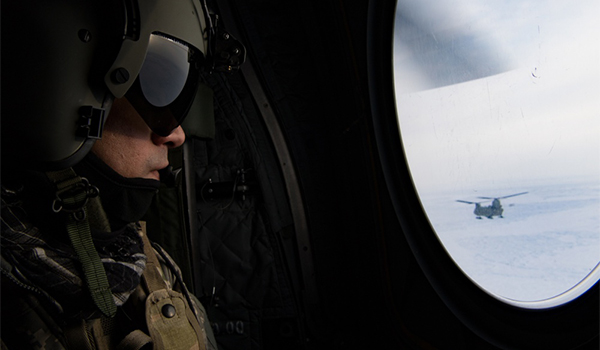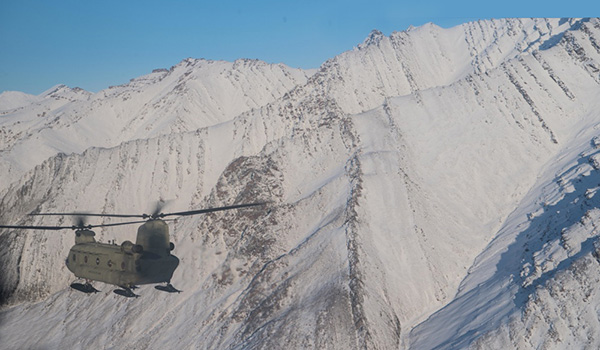
JOINT BASE ELEMENDORF-RICHARDSON, Alaska – Staring out the window of an Alaska Army National Guard CH-47 Chinook helicopter onto a endless sheet of ice, Staff Sgt. Jeremy Maddox finds himself in unfamiliar territory, over the frozen Beaufort Sea, 3,000 miles north of his hometown of Baker City, Oregon.

U.S. Army Staff Sgt. Jeremy Maddox assigned to the 2nd Battalion, 211th Aviation Regiment, looks out of the window on a CH-47 Chinook on Feb. 25, 2020, near Deadhorse, Alaska. The Alaska National Guard is hosting Exercise Arctic Eagle 2020, a joint-training exercise, Feb. 20 to March 6, 2020, throughout Alaska, including Joint Base Elmendorf-Richardson, Eielson Air Force Base, Fort Wainwright, the Yukon-Kuskokwim Delta and as far north as Teshekpuk Lake. As a homeland security and emergency response exercise, Arctic Eagle 20 is designed to increase the National Guard’s ability and effectiveness to operate in the extreme cold-weather conditions found in Arctic environments. / U.S. Air Force photo by Tech. Sgt. Amy Picard
After 12 years with the Oregon Army National Guard, the flight engineer and instructor, left behind the state’s Eastern Blue Mountains for more rugged and isolated terrain in Alaska.
“I moved my wife and kids and started my position with the Alaska National Guard on Feb. 1,” said Maddox, the newest member of 2-211th General Support Aviation Battalion based here. “I was at JBER for three weeks helping with maintenance and crewmember progression before supporting the Arctic Eagle portion of ICEX.”
A team of 20 Alaska National Guardsmen supported the Navy’s Ice Exercise several hundred miles north of the Alaska coastline February and March 2020, in conjunction with meeting training requirements for the Alaska National Guard’s Arctic Eagle 2020. AE20 is a statewide exercise that joined federal, state and local agencies in order to conduct sustained operations in extreme cold-weather conditions and rugged, harsh Alaska terrain.
Maj. Zachary Miller, officer in charge of the mission, explained that the Guardsmen began here and flew 700 miles north to Deadhorse as part of a long-range search and rescue operation in conjunction with the Alaska Air National Guard’s 176th Wing.
“One of the biggest things I think we do well here in the state is that we have a really good working relationship to get things done in probably one of the most austere environments in the world,” said Miller, who explained that the region has quite a few aviation operations going on. “If it’s a bad day for you, we have to collaboratively come together and use all our different resources to get out and get folks help.”
“Simultaneously, we are supporting the Arctic Submarine Laboratory out of San Diego, California, and basically making a push package for them to build an ice runway out in the Arctic,” said Miller, explaining that a push package contains the runway building supplies – all terrain vehicles, sleds, fuel, snow blowers and plows.

The Navy’s ASL serves as the lead organization for coordinating, planning and executing ICEX, involving five nations, two submarines and more than 100 participants over the three weeks of operations.
Miller said that the ASL reached out to the AKARNG to support with their heavy-lift helicopters to utilize their tremendous amount of capability for resupply mission for their training. He mentioned that the U.S. Army’s primary heavy troop and supply transport aircraft is phenomenal in bad weather, cold-weather conditions and has a tremendous amount of cargo capacity which was needed transporting 34,000 pounds of cargo during the exercise.
In addition to the cargo resupply mission, the Army Guardsmen, based out of Deadhorse Aviation Center, provided casualty evacuation coverage while personnel were inserted via paradrop operations onto the ice floe camp.
“I help load and plan out the cargo, and figure out which aircraft is taking what pieces of equipment to get it out to the ice,” said Maddox, who provided progression and flight training to some of the Guardsmen. “It’s a big aircraft and can fit a lot of stuff, you sometimes have to think outside the box as nothing ever loads perfect the first time. The crew really got to see how to cube out the aircraft effectively.”
Maddox is no stranger to the heavy lifting and long hours of missions having supported several joint exercises and two deployments to Iraq and Afghanistan. However, the environmental conditions were nothing close to what he was used to.
“Just after a minute of being outside, I had my eyebrows and eye lashes frost over. It was for sure the coldest temperatures I have ever been in,” said Maddox, who had the opportunity to don extreme cold weather gear for the first time. “I had never seen some of the items before. The issued snow shoes blew my mind and I of course had to try them out.”
Maddox’s experience proved to be invaluable to the team. Miller called him a tremendous asset – describing him as the subject matter expert on Chinook maintenance and all aspects of flight engineer duties. This proved to be especially helpful since the aircraft is new to the Alaska National Guard. Prior to 2019 the only helicopter the AKARNG operated was the UH-60 Blackhawk.
“With our new unit conversion, we are taking 20-year Blackhawk maintainers and trying to teach them a brand-new airframe that we have no history on,” said Miller. “We have good mechanics, who know how to work and operate in these conditions, but with little internal enlisted CH-47 experience we had to stack the deck in our favor with a guy like Maddox.”
“It’s been fantastic working with everyone,” said Maddox. “Everyone in the unit welcomed me with open arms and have treated me like I have been here for years.”
“Our unit has a tremendous amount of grit and I think that really goes to the Alaskan core and Alaskan spirit,” said Miller, noting his team’s problem-solving skills and attention to detail when things could become unsafe. “The core of the team up here has just been absolutely phenomenal.”
A number of Department of Defense exercises afford participating forces the opportunity to operate in a joint environment while assessing the ability to conduct sustained operations in arctic conditions including Arctic Eagle 2020, Alaskan Command’s Arctic Edge, and the U.S. Navy’s ICEX. The exercises occur in February and March 2020, and dates for each exercise varies.










